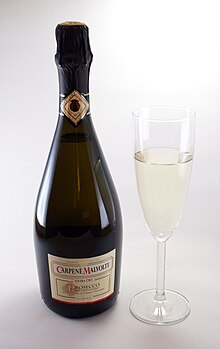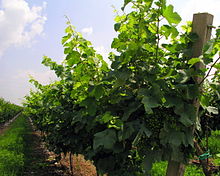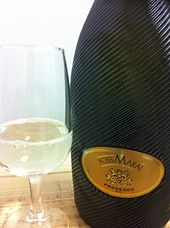Prosecco

Prosecco /pr[invalid input: 'ɵ']ˈsɛkoʊ/ (Italian: [proˈsekko]) is an Italian white sparkling wine, generally a dry or extra dry wine. It is made from Glera grapes, formerly known also as Prosecco, but other grape varieties such as Bianchetta Trevigiana may be included.[1]
The name is derived from that of the Italian village of Prosecco near Trieste, where the grape may have originated.[2] DOC Prosecco is produced in the regions of Veneto and Friuli Venezia Giulia, traditionally mainly around Conegliano and Valdobbiadene, in the hills north of Treviso.
Prosecco is the main ingredient of the Bellini cocktail and can be a less expensive substitute for Champagne.[3][4]
History

In Trieste at the beginning of the sixteenth century, the local wine "Ribolla" was promoted as the recreation of the Pucinian wine of antiquity, celebrated by Pliny the Elder in his Natural History and praised for its medicinal qualities by Livia, the wife of Emperor Augustus.[5] The need to distinguish the "Ribolla" of Trieste from other wines of the same name, produced in Gorizia and at lower cost in Istria, led, at the end of the century, to a change in name. Following the supposed place of production in antiquity, the wine was referred to as "castellum nobile vinum Pucinum", after the castle near the village of Prosecco.[5]
The first known mention of the name "Prosecco" is attributed to the Englishman Fynes Moryson, who, visiting the north of Italy in 1593, notes: "Histria is devided into Forum Julii, and Histria properly so called... Here growes the wine Pucinum, now called Prosecho, much celebrated by Pliny". He places Prosecco among the famous wines of Italy: "These are the most famous Wines of Italy. La lagrima di Christo and like wines neere Cinqueterre in Liguria: La vernazza, and the white Muskadine, especially that of Montefiaschoni in Tuscany: Cecubum and Falernum in the Kingdom of Naples, and Prosecho in Histria".[6]

The method of vinification, the true distinguishing feature of the original Prosecco, spread first in Gorizia, then – through Venice – in Dalmatia,[7] Vicenza and Treviso.[5] In 1754, the word "Prosecco" appears for the first time in the book Il roccolo Ditirambo, written by Aureliano Acanti: 'And now I would like to wet my mouth with that Prosecco with its apple bouquet'.[8]
Up until the 1960s, Prosecco sparkling wine was generally rather sweet and barely distinguishable from the Asti wine produced in Piedmont.[9] Since then, production techniques have improved, leading to the high-quality dry wines produced today.[9] According to a 2008 New York Times report, Prosecco has risen sharply in popularity in markets outside Italy, with global sales growing by double-digit percentages since 1998, aided also by its comparatively low price.[2][4] It was introduced into the mainstream U.S. market in 2000 by Mionetto, now the largest importer of Prosecco, who also reported an "incredible growth trend" in 2008.[4]
Until the 2008 vintage Prosecco was protected as a DOC within Italy,[10] as Prosecco di Conegliano-Valdobbiadene, Prosecco di Conegliano and Prosecco di Valdobbiadene. From 2009, this has been promoted to DOCG status.[11] To further protect the name, an association of traditional Prosecco growers is advocating a protected designation of origin status for Northern Italian Prosecco under European law.[2] Since 1 January 2010, Prosecco is, according to an order of the Italian Minister of Agriculture of 17 July 2009, not the name of a grape variety any more (now to be called Glera), but exclusively a geographical indication. This was confirmed by EG-Regulation Nr. 1166/2009 of 30 November 2009.[12]
Production

Unlike Champagne, its main commercial competitor, Prosecco usually is produced using the Charmat method, in which the secondary fermentation takes place in stainless steel tanks,[13] making the wine less expensive to produce. The rules for the DOCG Prosecco Valdobbiadene also allow the use of the Metodo Classico: secondary fermentation in the bottle.
Approximately 150 million bottles of Italian Prosecco are produced annually.[2] As of 2008, 60 percent of all Prosecco is made in the Conegliano and Valdobbiadene area.[2] Production there amounted to €370 million in 2007.[2] Since the 2000s, Glera (Prosecco) grapes also are cultivated and wine from the grapes is produced in other countries including Brazil, Romania, Argentina, and Australia.[2]
In the region of Conegliano and Valdobbiadene there are more than 150 producers[14] and they form together the Consortium for the Protection of Prosecco from Conegliano and Valdobbiadene (Consorzio per la Tutela del Prosecco di Conegliano e Valdobbiadene).
Variants

Prosecco is produced mainly as a sparkling wine in either the fully sparkling (spumante) or lightly sparkling (frizzante, gentile) varieties.[15] Prosecco spumante, which has undergone a full secondary fermentation, is the more expensive variant.[16] The sparkling variants may contain some Pinot bianco or Pinot grigio wine.[15] Depending on their sweetness, in accordance with the EU Sweetness of wine Regulations for Terms used to indicate sweetness of sparkling wine, Proseccos are labelled "Brut" (up to 12 grams per litre of residual sugar), "Extra Dry" (12–17 g/l) or "Dry" (17–32 g/l).[3]
A still wine (calmo or tranquillo) also is made from Glera grapes – it amounts to only about five percent of production,[10] but this wine is rarely exported.
Wines from the traditional Conegliano–Valdobbiadene production area are labeled as "Prosecco di Conegliano-Valdobbiadene", "Prosecco di Conegliano", "Prosecco di Valdobbiadene", or "Prosecco DOC" from Friuli. Proseccos labeled with another, non-protected designation, such as "IGT-Veneto", are generally cheaper and of a more varied quality.[17]
Cartizze Prosecco
The hill of Cartizze is a 1,000-foot-high vineyard of 107 hectares (260 acres) of vines,[18] owned by 140 growers.[9] The Prosecco from its grapes, of which comparatively little is produced, is widely considered to be of the highest quality,[9][17][19][20][21] or even the "Grand Cru" of Prosecco.[3][22][23] Accordingly, a hectare of Cartizze grape land is estimated to be worth in excess of one million US dollars.[2]
According to a local legend, Cartizze grapes traditionally were harvested last, as the vines were situated on steep slopes and hard to reach, which made vintners discover that this extended ripening period improved the flavour.[17] Nonetheless, in a blind tasting at the 2006 Vinitaly trade fair, Cartizze spumanti were ranked consistently behind "normal" Prosecco.[24]
Consumption

In Italy, Prosecco is a ubiquitously utilized wine.[2] Outside Italy, it is most often drunk as an apéritif, much as Champagne is. As with other sparkling wines, Prosecco is served chilled.[9]
Unlike Champagne, Prosecco does not ferment in the bottle, and it grows stale with time. It should be drunk as young as possible,[24] preferably within three years of its vintage, although high-quality Prosecco may be aged for up to seven years.[25]
Compared to other sparkling wines, Prosecco is low in alcohol, about 11 to 12 percent by volume.[9] The flavor of Prosecco has been described as intensely aromatic and crisp, bringing to mind yellow apple, pear, white peach, and apricot.[4][9] Unlike Champagne, appreciated for its rich taste and complex secondary aromas,[9] most Prosecco variants have intense primary aromas[9] and are meant to taste fresh, light and comparatively simple.[3]
Most commonly Prosecco is served unmixed, but it also appears in several mixed drinks. It was the original main ingredient in the Bellini cocktail and in the Spritz cocktail, and it can also replace Champagne in other cocktails such as the Mimosa.[26] With vodka and lemon sorbet, Prosecco is also an ingredient of the Italian mixed drink Sgroppino.
See also
References
- ^ J. Robinson, J. Harding and J. Vouillamoz Wine Grapes - A complete guide to 1,368 vine varieties, including their origins and flavours pgs 102-103, 853-854 Allen Lane 2012 ISBN 978-1-846-14446-2
- ^ a b c d e f g h i Cortese, Amy, The New York Times (December 26, 2008). "Italian Makers of Prosecco Seek Recognition". Retrieved 2008-12-28.
{{cite web}}: CS1 maint: multiple names: authors list (link) Cite error: The named reference "NYT" was defined multiple times with different content (see the help page). - ^ a b c d Atkin, Tim (November 11, 2007). "The fizz that's the bizz". The Observer. London. Retrieved 2008-12-29.
- ^ a b c d Dane, Ana (July 3, 2006). "Pop the Cork on Prosecco". TheStreet.com. Retrieved 2008-12-29.
- ^ a b c Fulvio Colombo, Prosecco. Patrimonio del Nordest (in italian), Luglio Editore, Trieste 2014, ISBN 978 8868030636 and Prosecco, perché? Le nobili origini di un vino triestino (in italian), Luglio Editore, Trieste 2012, ISBN 978 8896940877
- ^ F. MORYSON, An Itinerary. Containing His Ten Yeeres Travell through the Twelve Dominions of Germany, Bohmerland, Sweitzerland, Netherland, Denmarke, Poland, Italy, Turky, France, England, Scotland & Ireland, IV, pp. 80, 103, Glasgow 1908.
- ^ Fulvio Colombo, Storie di vini dell’Adriatico. Nuove indagini sulle relazioni tra il Prosecco e il Prošek dalmata, (in Italian) La Ricerca. Bollettino del Centro di Ricerche Storiche di Rovigno, 65 (giugno 2014), pp. 11-13.
- ^ http://www.discoverproseccowine.it/en/the_prosecco/history/
- ^ a b c d e f g h i Kinssies, Richard (July 10, 2002). "On Wine: Proseccos sparkle on their own terms". Seattle Post-Intelligencer. Retrieved 2008-12-29.
- ^ a b DuBose, Fred; Spingarn, Evan; Maniscalco, Nancy (2005). The Ultimate Wine Lover's Guide 2006. Sterling Publishing Company, Inc. p. 196. ISBN 1-4027-2815-8.
- ^ Natasha Hughes (2009-05-28). "Prosecco to become DOCG". decanter.com. Retrieved 2009-05-28.
The current Prosecco di Conegliano e Valdobbiadene [sic] DOC zone will become a DOCG from the 2009 vintage onward. Announcing the move, Prosecco DOC director Giancarlo Vettorello said that the IGT zone, which lies in the plains between Friuli and Veneto, will be upgraded to DOC status.
- ^ EG Verordnung Nr. 1166/2009 of 30 November 2009
- ^ Matias, Neil (December 26, 2008). "Bubbling over into '09". The Herald News. Retrieved 2008-12-28.
- ^ http://www.prosecco.it/en/consorzio/cantine.php
- ^ a b Jackson, Ron S. (2000). Wine Science. Academic Press. p. 511. ISBN 0-12-379062-X.
- ^ Höß, Alexandra (2005). Ökotrophologie 2. Verlag Neuer Merkur GmbH. p. 150. ISBN 3-937346-03-1.
- ^ a b c LeSinge, Theodore (2003). ADAC Reiseführer Venetien/ Friaul (in German). ADAC Verlag DE. p. 78. ISBN 3-89905-116-5.
- ^ Cannavan, Tom (2004). "the Proseccos of Bisol". wine-pages.com.
- ^ Koelliker, Beat (2008). Die neue Hallwag Weinschule: Mit 13 Weinproben zum Weinkenner (in German). HALLWAG. p. 104. ISBN 3-8338-1221-4.
- ^ Difford, Simon (2007). Cocktails. diffordsguide. p. 398. ISBN 0-9556276-0-5.
- ^ Belford, Ros (2003). Rough Guide to Italy. Rough Guides. p. 282. ISBN 1-84353-060-0.
- ^ Prosecco.The white sparkling from Veneto
- ^ Yarrow, Alder (July 14, 2007). "The World's Best Prosecco: Tasting Conegliano Valdobbiadene". Vinography.
- ^ a b Burianek, Stephan (June 10, 2007). "In dubio Prosecco". Der Standard (in German). Retrieved 2008-12-29.
- ^ Mitchell, Sandy. "Prosecco, Italy's Sparkling Wine". Retrieved 2011-05-07.
- ^ "Rich Prosecco" (in German). http://www.richprosecco.com. Retrieved 14 February 2014.
{{cite web}}: External link in|publisher=
